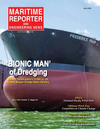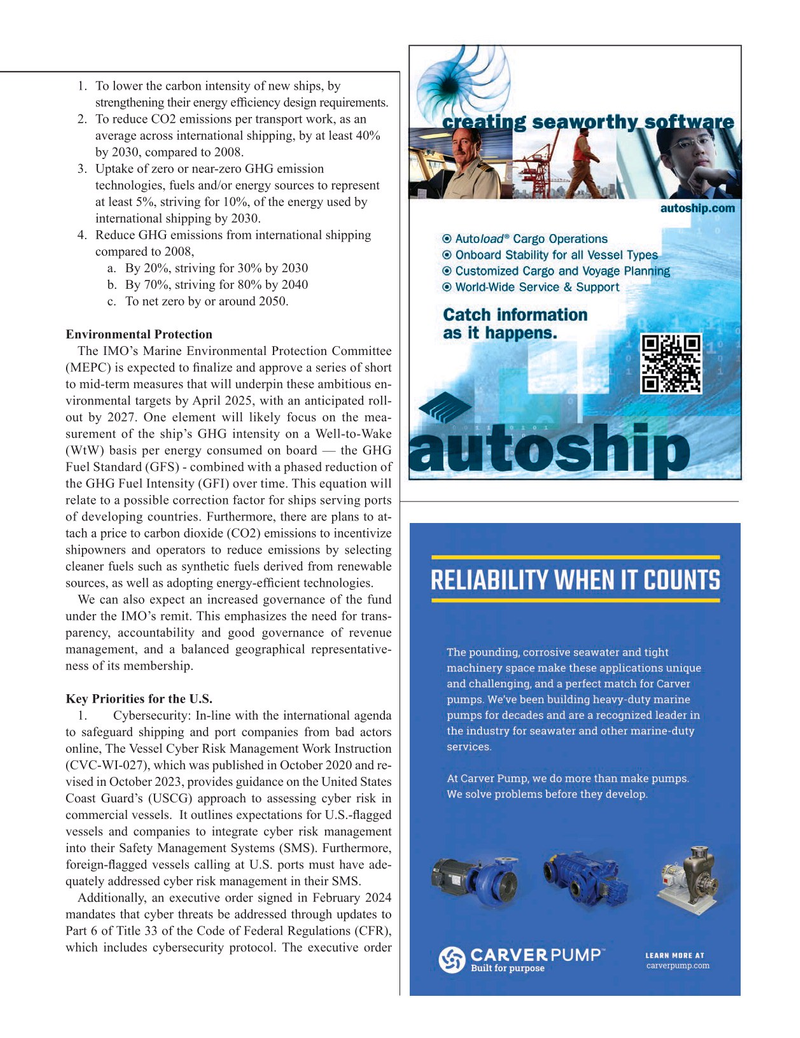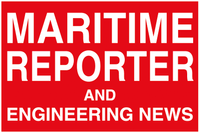
Page 23: of Maritime Reporter Magazine (April 2025)
Read this page in Pdf, Flash or Html5 edition of April 2025 Maritime Reporter Magazine
1. To lower the carbon intensity of new ships, by strengthening their energy ef? ciency design requirements.
2. To reduce CO2 emissions per transport work, as an average across international shipping, by at least 40% by 2030, compared to 2008.
3. Uptake of zero or near-zero GHG emission technologies, fuels and/or energy sources to represent at least 5%, striving for 10%, of the energy used by international shipping by 2030.
4. Reduce GHG emissions from international shipping compared to 2008, a. By 20%, striving for 30% by 2030 b. By 70%, striving for 80% by 2040 c. To net zero by or around 2050.
Environmental Protection
The IMO’s Marine Environmental Protection Committee (MEPC) is expected to ? nalize and approve a series of short to mid-term measures that will underpin these ambitious en- vironmental targets by April 2025, with an anticipated roll- out by 2027. One element will likely focus on the mea- surement of the ship’s GHG intensity on a Well-to-Wake (WtW) basis per energy consumed on board — the GHG
Fuel Standard (GFS) - combined with a phased reduction of the GHG Fuel Intensity (GFI) over time. This equation will relate to a possible correction factor for ships serving ports of developing countries. Furthermore, there are plans to at- tach a price to carbon dioxide (CO2) emissions to incentivize shipowners and operators to reduce emissions by selecting cleaner fuels such as synthetic fuels derived from renewable sources, as well as adopting energy-ef? cient technologies.
We can also expect an increased governance of the fund under the IMO’s remit. This emphasizes the need for trans- parency, accountability and good governance of revenue management, and a balanced geographical representative- ness of its membership.
Key Priorities for the U.S.
1. Cybersecurity: In-line with the international agenda to safeguard shipping and port companies from bad actors online, The Vessel Cyber Risk Management Work Instruction (CVC-WI-027), which was published in October 2020 and re- vised in October 2023, provides guidance on the United States
Coast Guard’s (USCG) approach to assessing cyber risk in commercial vessels. It outlines expectations for U.S.-? agged vessels and companies to integrate cyber risk management into their Safety Management Systems (SMS). Furthermore, foreign-? agged vessels calling at U.S. ports must have ade- quately addressed cyber risk management in their SMS.
Additionally, an executive order signed in February 2024 mandates that cyber threats be addressed through updates to
Part 6 of Title 33 of the Code of Federal Regulations (CFR), which includes cybersecurity protocol. The executive order
MR #4 (18-33).indd 23 4/4/2025 4:02:04 PM

 22
22

 24
24
